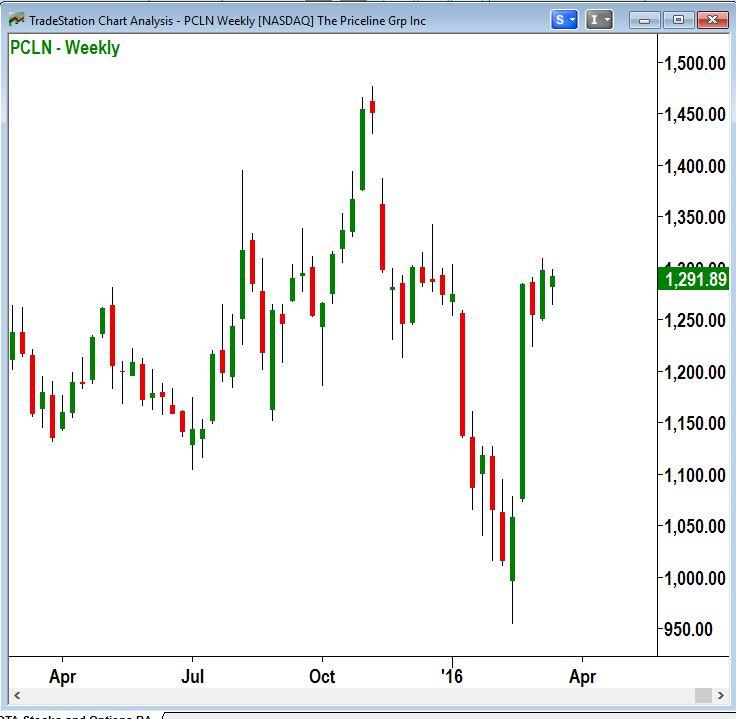Using Options to Trade High-priced Stocks – Part 2
|Last week I described a way to use options as a way to trade high-priced stocks, like Google or Priceline, with much less cost and risk than trading the stocks themselves. Below is the chart of Priceline as of our starting point on March 9, 2016.
I compared two alternative trades to implement a bearish outlook:
Sell the stock short at the price at the time around $1292, with a target around $1100 and a stop-loss price at around $1310.
Buying a July put option at the $1300 strike, with orders in place to close out the trade if PCLN hit either our $1310 stop or $1100 target.
That article calculated that of the two trades, the put purchase had a potential to make 62% of the profit that the short stock sale would make if the stock reached the $1100 target; while tying up only 15% as much cash, for a much better cash-on-cash return. Today let’s look at using an additional option to improve the risk-reward possibilities even further.
At the time that we could have bought the $1300 put described before for $90.70 per share, we could have simultaneously sold a put near our $1100 target and received about $20.00 per share. Changing this trade from a simple long option into a vertical spread would do several things:
It would reduce the net cash out of pocket required to enter the trade, from $90.70 to $70.70 per share, since we would be collecting $20 per share for the short 1100-strike put.
If PCLN rallied to the $1310 stop-loss point, the loss would be less by about two dollars per share – about $14 per share instead of about $16 per share with the long put alone. This is because the short put would lose value in that case (good for us), and this would partially offset the loss in value of our long $1300-strike put.
If PCLN did drop down to the $1100 target, the profit on the trade would be about the same with or without the short put, if the decline took a long time. If it took a short time, the spread would not do quite as well as the long put alone.
Options at any moment in time may be cheap or expensive, in terms of the amount that traders are willing to pay per unit of time. This factor is dynamic – when expectations change, the option value per unit of time changes too. We call this factor implied volatility. When we simply own an option, we are fully exposed to those changes in expectations. When we are both short and long options at the same time, then our exposure to these changing expectations is diminished. In this case, options were a little on the cheap side, but not by much. Since they were not extremely cheap they could still get cheaper; so we would want to reduce our exposure to that possibility. Adding the short option to the long option offsets some of our exposure to a change in implied volatility.
Creating this vertical spread was one of a number of ways we could have matched our outlook on the stock’s price to an option strategy. Options can be put together like Lego blocks to create different types of positions for different situations. We can finely tune these positions in ways that are not possible with any other instrument. And, using options can give us entrée to trading in stocks that might otherwise be beyond our reach.
The selection of the right strategy is key to option profits. In our classes, we lay out a simple two-step process for selecting a strategy in any given situation. When you know how the pieces fit together, the puzzle becomes a picture.
Information on these pages contains forward-looking statements that involve risks and uncertainties. Markets and instruments profiled on this page are for informational purposes only and should not in any way come across as a recommendation to buy or sell in these assets. You should do your own thorough research before making any investment decisions. FXStreet does not in any way guarantee that this information is free from mistakes, errors, or material misstatements. It also does not guarantee that this information is of a timely nature. Investing in Open Markets involves a great deal of risk, including the loss of all or a portion of your investment, as well as emotional distress. All risks, losses and costs associated with investing, including total loss of principal, are your responsibility. The views and opinions expressed in this article are those of the authors and do not necessarily reflect the official policy or position of FXStreet nor its advertisers.
